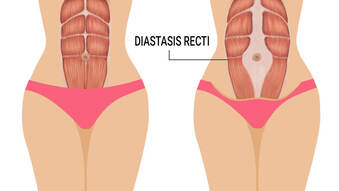|
Back to Blog
What is Abdominal Separation?2/13/2021  What is Diastasis Recti? During pregnancy, you may have noticed a separation of your rectus abdominis or “six pack” muscles. These muscles are connected by the linea alba at the midline of your stomach. The partial or complete separation of these muscles is called Diastasis recti. This is very common during and following pregnancy. if the muscles don’t go back together spontaneously, you may suffer long term effects. Symptoms can include “bulging”, “tenting” or “doming” of the abdominal contents through the separation. You may not have pain or discomfort, but you may have increased sensitivity in the area. Other symptoms can include back pain, feelings of core weakness or instability. How can I check if I have it? An easy way to check if you have the separate is to lie on your back with your knees bent and feet on the floor. Press your fingers down gently in your belly button and perform a mini crunch only until your shoulders come up. Feel for the sides of your rectus abdominis muscles with your fingers. Separation is commonly discussed in terms of finger widths -- for instance, two or three (or more) fingers' separation. What can be done to fix it? Strengthening of the transverse abdominis in conjunction with the pelvic floor muscles can help close the separation and provide good core stability. While you have the separation, avoid doing crunches, planks or high level core exercises. A Pelvic Physical Therapist can diagnosis Diastasis Recti and provide weekly sessions with appropriate progression. Patients who are consistent with home exercises and treatments start to see changes with in a few weeks of training. |